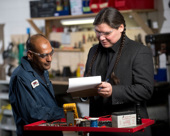Once you've written your resumé, check it for completeness and polish. Use the first checklist to ensure your resumé includes all relevant information. Use the second checklist to ensure your resumé is clear and professional.
Make sure your resumé is complete. Did you include:
- Your contact information: name, mailing address, email address, and phone number(s)? If it makes sense for an employer to see your website, add its address.
- An objective that briefly describes how your skills can help this employer reach his or her goals.
- Your education and training that relates to the job you want. List the school name, program, areas of study, and your degree, certificate, or diploma.
- Your work history or experience, depending on your resumé type. List job titles, employer names, dates of employment, and work duties. You can include volunteer work, especially if you don’t have much paid work experience.
- Your work-specific skills, focusing on the ones that relate to the position you’re applying for.
- The same keywords from the job posting to link your skills to the job’s requirements.
- Other languages you speak, read, or write. Indicate if you’re fluent or have a reading or speaking knowledge of a language.
- Any honours or awards you’ve received.
- School or community projects that showcase your skills and leadership. This is especially useful if you don’t have much work experience.
- Activities and interests that involve relevant skills or knowledge.
- Volunteer activities and community involvement. These details show an employer you’re well-rounded. Be aware that mentioning religious or political memberships is usually not appropriate.
Make sure your references are not on your resumé. Bring your references with you to the interview on a separate sheet of paper.
Make sure your resumé is polished. Check that it:
- Is error free
- Is direct, clear, and 1 to 2 pages long
- Has enough white space so it looks professional and easy to read
- Does not include a:
-
- Title such as “Resumé”
- Date (this goes on your cover letter)
- Signature (this goes on your cover letter)
- Photograph
- Personal information such as age, sex, height, or ethnic background
-
- Shows you can meet the needs of the specific job for which you’re applying
- Lists your strongest qualifications first
- Describes how you solved problems and achieved goals in your work
- Uses action words
- Avoids filler words, such as “I was responsible for ” or “My duties involved”
- Describes your experience and skills honestly
- Is printed on good quality white or off-white 8.5” by 11” paper
Ask for feedback
When you’re sure you’ve written the best possible draft, ask your family and friends to check your resumé for errors. Their feedback can make a big difference.
Show your draft to people who work in the field you want to work in. Review their feedback and make the changes that seem right to you.
Finishing touches
When you mail, email, or deliver your resumé to an employer, always include a cover letter or message. If you meet the job requirements and your cover letter and resumé show the employer you’re a good fit for the position, chances are you’ll be invited for an interview.










